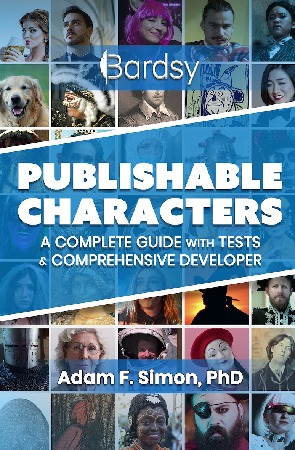😃 Subscribe for Weekly Posts:


All auteurs leave traces of themselves; bend to this necessity and make this transfer consciously
Is creating a worthy character an impossible task? Of course not! Yet, it takes effort. Unlike actual people, fictional beings are constructed, not born. That said, your readers must relate to them as if they were made of flesh and blood. To jump start this process, Bardsy has developed a Character Equation, which our new guide: Publishable Characters: A Complete Guide With Tests & Comprehensive Developer, presents in full.
This equation is the first piece of a two-part recipe -- finding the ingredients and the second part is blending -- that will produce an irresistible being, a main character that prompts the deep empathy that turns good novels into great ones. This blog goes over the first ingredient, Parts of You. We'll pick up next time with the second ingredient, Cultural Universals, and then the third, Distinctive Referents, after that. Don't forget our Comprehensive Character Developer, which offers a way to build your characters online.
All authors leave pieces of themselves in their stories. Sometimes it's unintentional; nevertheless, some part of the creator necessarily appears in every creation. The idea here is to make a virtue of this necessity and carefully extract aspects of your identity to embed in your being. Think of it as an artist's signature; a defining factor that makes your creature completely and unarguably yours. This practice offers advantages, too. Writing what you know helps you build multifaceted characters that entice reader investment, leading to the deep empathy, the vicarious thrill, that all great characters inspire.
Go Ahead, Cannibalize Yourself!
When you write from yourself, you're pulling from the most authentic source you have. The smallest slice of yourself can magically spark life within your beings. And, as said: you really can't avoid it. Whether you write yourself into your work intentionally or not, fragments of you are
always falling onto the page. It's inevitable. Put another way, don't apply advice about avoiding author self-insertion, uncritically.
We only ever see the world through the narrow lens of our own minds. We can
roleplay, research, and imagine, but we can't ever be someone else. But don't worry! That's a good thing; most obviously because it's central to a novel's experience. Every character you create overlaps with you in some way. Instead of fighting, lean into this truth and accept that parts of you, good or bad, likeable or not, will seep into your characters. Better yet, become aware, and leverage it to your advantage.

Transplant those slices of thoughts and behaviors, like a sense of humor or love of music, into your being.

The benefits are huge. For starters, writing from your own experience and personality is far easier than inventing these from scratch. Your thoughts, emotions, and instincts flow freely onto the page because they're already yours. If you studied ancient history in college then writing about Greco-Roman societies, architecture, and agriculture for your historical drama should feel like second nature. If you've spent years working in a coffee shop, then working espresso
machines, crafting cold foams, and the scent of roasted coffee beans will flow naturally into your
romantic contemporary. That's why the old saying "write what you know" holds so much weight. It doesn't mean you're creating a mirror image rather that transferring some of yourself and your lived experience gives you an incredible resource.
Of course, intentionally also matters. Carefully examining your traits and putting some into your creation offers the quickest route to success. In this vein, the most salient aspects make the easiest transplants. Take a step back and observe yourself. Consider your daily routines, your
bad habits, your interests, and obsessions, and mentally (or physically) list them. They
don't all have to be positive! The way you snort when you laugh too hard could be a dorky
quality for your otherwise flawless love interest. The way you wring your hands when nervous can bring a humanizing aspect to your antagonist. Perhaps even your obsession with strawberries can be an unexpected yet adorable charm to give to your main character, creating
a certain authenticity readers won't forget.
It's not just about convenience either. Don't weave pieces of yourself into your work because its
easy. In fact, challenge yourself to consider as many aspects as you can. Write yourself into your characters to build connection. Readers crave characters they can relate to and project themselves onto. Give them someone interesting by weaving in the most interesting parts of you.
But, Be Intentional…
While a handful of your quirks may be the perfect addition to your character recipe, when
sprinkled sparingly, be careful not to overindulge. The most important rule is to construct your character to suit the story (and vice versa). We'll be discussing this in future blogs. For now, be precise and set conscious boundaries on the parts you include. A select all, copy-and-paste of yourself, also called a self-insert, often reads as indulgent or flat, losing the magic of relatability. This is where the infamous Mary Sue or Gary Sue trope comes in; a character who is essentially the author in disguise, often idealized to the point of perfection. Readers see through this, and feel distanced instead of connected. An immaculate being, moreover, has nothing at stake.

Be precise and set conscious boundaries on your transfers to avoid self-indulgence.

Your goal is to not immortalize a highly glamorized version of yourself on the page, but to rework
pieces of yourself as well as other ingredients into new people (or aliens) who stand on their own. The first trick is to select a whole chunk of yourself. For example, your nervous hands are symptomatic of a deeper reaction to stressful situations. Adding them to your character encourages you to think about what stresses you, not to mention other reactions, and transfer that material as well. In this way, you're adding genuine pieces of yourself to your being and not tacking things on.
Try it to see that this process is easier than you may expect. Remember, the best way to write someone unforgettable is to start with someone you already know—you. So don't hesitate to contribute your beloved passions, your detested flaws, and your most
treasured memories to your cast.
Use our Comprehensive Character Developer to construct your being online for an extra boost. It produces a downloadable character sheet pdf. Finally, stay tuned for our next character equation ingredient:
Cultural Knowledge.